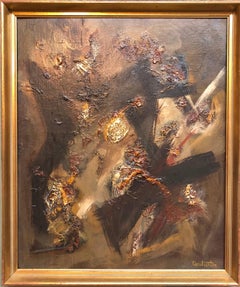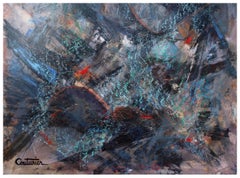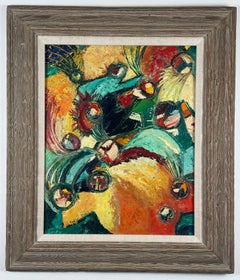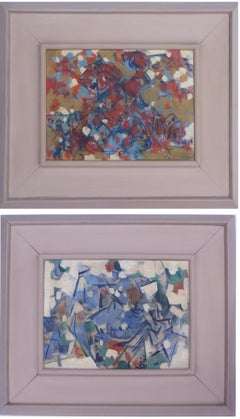Rene Couturier Abstract Paintings
Rene Couturier is known for abstract still life, figure and landscape painting. This expressive French colorist was born in Dieppe, Normandy, in 1933 and attended the École des Beaux-Arts of Marseilles. From 1958–68, he was represented in several groups and salon shows in France. Since completing his studies, Rene has lived in Mexico, the United States, Africa and France and has exhibited internationally with success.
to
1
1
Overall Width
to
Overall Height
to
2
1
1
2
1
1
2
2
1
1
1
4
664
620
458
342
2
Artist: Rene Couturier
French Gestural Abstract Expressionist Textured Oil Painting
By Rene Couturier
Located in Surfside, FL
Rene Couturier lives in the Netherlands and France. Rene Couturier is known for abstract still life, figure and landscape painting.
Rene' Couturier is an artist whose works displays...
Category
1970s Abstract Expressionist Rene Couturier Abstract Paintings
Materials
Canvas, Oil
Space Abstract, Mid Century Abstract Expressionism with Grey, Black, Blue, Red
By Rene Couturier
Located in Soquel, CA
Dynamic midcentury modern abstract expressionist painting by Normandy artist Rene Couturier (French, b. 1933), circa mid-1960s. A grey and black plane comprised of clashing diagonals...
Category
1960s Abstract Expressionist Rene Couturier Abstract Paintings
Materials
Masonite, Oil
Related Items
Untitled (Abstract Expressionist Painting)
By Bertha Davis
Located in Wilton Manors, FL
Bertha G. Davis (1911-1997)
Untitled, ca. 1960's
Oil on cradled masonite panel.
16 x 20 inches; 24 x 28 inches framed.
Signed lower left. Artist estate stamp on verso.
Vintage custom wormy chestnut frame.
A painter of cityscapes, landscapes, and abstracts in Texas, Bertha G Davis was primarily a self-taught artist whose style was influenced by her early life experiences in pre-World War II Lithuania and later Mexico. Her style is expressionistic*, relying on color to denote her profound feelings. She works primarily in watercolor and acrylic with some mixed media*.
She is the daughter of Abraham and Dvora Germaize of Vilna, Lithuania and grew up in Jewish ghettos in Vilna, Alita, and Kovno. Davis was influenced by her father who was a decorative wood-worker and carpenter in Lithuania. The family of five daughters and a son escaped to Mexico City in the late 1920’s because of Jewish oppression. The images and emotions she experienced had no outlet.
She was known as a beauty, and at age 17 was named Jewish Miss Mexico, barely able to speak Spanish having just emigrated from Eastern Europe. Irving Davis, a merchant from Texas who had also come from Eastern Europe via Cuba, saw her at this event where she was crowned Jewish Miss Mexico, and three days later asked for her hand in marriage. They moved to a small town in Texas, raising a family.
Her daughter, Sylvia, was born when Davis was 20 and they were inseparable. As Sylvia became an actress, painter, and sculptor, Davis was amazed at the capacity for creativity. Davis didn’t begin her own artistic journey until she was 47, when her daughter Sylvia Caplan encouraged her to try. She was inspired by this daughter who gave her a drugstore palette of watercolors, paper and brushes and told her to “just try.” Davis did not put down her palette and brushes until her death in 1997.
Bertha G Davis was primarily self-taught but maintained a style oriented toward color and texture that reflected her strong feelings. Most of her early work was done while she lived in McAllen, Texas where she was known for her contribution to art and showed her work and the work of other artists at the Bertha Davis Gallery.
She studied with Stewart Van Orden, at Pan American College in 1960-61; and was a student at the Art Institute San Miguel Allende, Mexico, 1965. She was also a student of Harold Phenix...
Category
Mid-20th Century Abstract Expressionist Rene Couturier Abstract Paintings
Materials
Masonite, Oil
$975 Sale Price
35% Off
H 28 in W 24 in D 1 in
Abstracted pair of oil paintings by Carl Holty
By Carl Holty
Located in Hudson, NY
These artworks by Carl Holty are only sold as a pair. Each painting measures 9" x 11" and framed 18" x 20.25" x 2.5"
The red and gold work is signed "Carl Holty" in the lower right.
About this artists: Carl Holty was awakened to his interest in art as a child through visits to the Layton Art Gallery of Milwaukee, and began painting lessons with Friedrich Wilhelm Heine at a young age. Though born in Freiburg, Germany, in 1900, he was raised in Wisconsin and enrolled at Marquette University. Before long, Holty abandoned his pre-medical studies in order to pursue art. He spent a summer at the School of the Chicago Art Institute in Saugatuck, Michigan, and set off for New York in 1920. He then studied at the National Academy of Design under Francis Coates Jones...
Category
1940s Abstract Expressionist Rene Couturier Abstract Paintings
Materials
Canvas, Oil
"Crossed Arms" Mid Century Abstract Expressionist NYC Female Artist
By Sylvia Rutkoff
Located in Arp, TX
Sylvia Rutkoff (1919-2011)
Sr5-1
c.1960s
“Crossed Arms”
Acrylic on Masonite
36x42 period frame
Unsigned
Collection acquired from family estate
Category
Mid-20th Century Abstract Expressionist Rene Couturier Abstract Paintings
Materials
Masonite, Oil
$4,000
H 36 in W 42 in D 2 in
Edge
Located in Austin, TX
Waterline Fine Art, Austin, TX is pleased to present the following work:
Oil on board. Signed and dated lower right and verso, titled verso.
36.25 x 48 in.
40.5 x 52.25 in. (framed)
Framed in contemporary silver, tiered floater frame.
Dennis Eugene Norman Burton was a Canadian modernist who was born in Lethbridge, Ontario. He attended the Ontario College of Art from 1952 to 1956, and worked for the Canadian Broadcasting Corporation (CBC) as a graphic designer until 1960.
Inspired by a 1955 exhibition of the “Painters Eleven” at Toronto’s Hart House, as well as American Abstract Expressionist artists such as Robert Motherwell, Jack Tworkov, and Willem de Kooning, Burton shifted his focus toward abstraction in the mid-1950s.
Burton showed with the famed Isaacs Gallery in Toronto, becoming one of the youngest members on the gallery’s roster. A talented musician, he also played saxophone in the Artist’s Jazz Band in Toronto - a pioneering Canadian free-jazz group...
Category
1950s Abstract Expressionist Rene Couturier Abstract Paintings
Materials
Masonite, Oil, Board
Abstract Seated Figure
By Norbert Lenz
Located in Indianapolis, IN
Lenz was born in Norwalk, OH on March 2, 1900. A twentieth century American painter, illustrator and commercial artist, Lenz received his artistic education at the Huntington Polyte...
Category
20th Century Abstract Expressionist Rene Couturier Abstract Paintings
Materials
Masonite, Oil
Bold German American Abstract Expressionist Color Field Oil Painting Carl Holty
By Carl Holty
Located in Surfside, FL
Carl Robert Holty (American 1900-1973)
Abstract Expressionism Oil on Masonite board.
Abstract with greens blues and red,
Dimensions 12 x 9-1/2 inches. Framed 17 X 14 inches
Hand...
Category
20th Century Abstract Expressionist Rene Couturier Abstract Paintings
Materials
Masonite, Oil
Rock Candy Mountain (unique, signed Abstract Expressionist painting) framed 70s
By Ben Wilson
Located in New York, NY
Ben Wilson
Rock Candy Mountain, ca. 1970
Oil on masonite board (Hand Signed, titled and dated)
Hand signed, titled and dated by Ben Wilson on the back
Frame Included: held in artist'...
Category
1970s Abstract Expressionist Rene Couturier Abstract Paintings
Materials
Masonite, Oil, Permanent Marker
$7,000
H 25 in W 49 in D 1 in
Untitled
Located in Austin, TX
Waterline Fine Art, Austin, TX is pleased to present the following work:
Oil on canvas. Signed verso. Some scratched out, illegible writing in paint and graphite verso, which may ha...
Category
1960s Abstract Expressionist Rene Couturier Abstract Paintings
Materials
Canvas, Oil
Byzantium, original signed painting by renowned Abstract Expressionist, Framed
By Ben Wilson
Located in New York, NY
Ben Wilson
Byzantium, 1975
Oil on Masonite painting
Hand signed reverse, Titled, "Byzantium", dated 1975 by the artist and also with estate stamp - in addition to Ben Wilson's hand s...
Category
1970s Abstract Expressionist Rene Couturier Abstract Paintings
Materials
Masonite, Oil
$12,000
H 19.5 in W 16.5 in D 1.5 in
April 10, 1961
Located in Austin, TX
Waterline Fine Art, Austin, TX is pleased to present the following work:
Oil on canvas. Signed and dated lower right; signed, titled, dated verso.
48 x 60 in.
49.75 x 61.75 in. (framed)
Custom framed in a solid maple floater, with an heirloom white finish.
Provenance
Kootz Gallery, New York
Collection of John G. and Kimiko Powers, New York/Aspen, CO
Prentice-Hall Corporate Art Collection, New York
Kyle Morris was born in Des Moines, IA in 1918. After serving in the U.S. Air Force during World War II, he completed M.F.A. programs at both Northwestern and Cranbrook Academy of Art before settling in New York and renting a studio on Mercer Street in downtown Manhattan during the 1950s. Transitioning away from the figurative painting of his formal training, he began to create the bold gestural works that would serve as his hallmark in the ever-growing fraternity of the New York School.
Morris’ first major solo exhibition occurred at the Walker Art Center in Minneapolis in 1952. This show served as the catalyst for his recruitment onto the rosters of the prominent Stable and Kootz galleries in New York. In 1961, he was included in the Guggenheim’s landmark exhibition, American Abstract Expressionists and Imagists, which surveyed the abstract expressionist movement that would come to dominate contemporary American art...
Category
1960s Abstract Expressionist Rene Couturier Abstract Paintings
Materials
Canvas, Oil
Untitled Abstract Oil by Naohiko Inukai
Located in Hudson, NY
A richly colored abstraction by Japanese artist Naohiko Inukai. This early work demonstrates the artist's fluidity and expression with paint prior to wh...
Category
1960s Abstract Expressionist Rene Couturier Abstract Paintings
Materials
Canvas, Oil
Untitled
By Michael Goldberg
Located in Austin, TX
Waterline Fine Art, Austin, TX is pleased to present the following work:
Oil, pastel, and paper collage on canvas. Signed and dated verso.
52.75 x 47.75 in.
54 x 49 in. (framed)
Gilded floater frame.
Provenance
Compass Rose, Chicago
Born Sylvan Irwin Goldberg in 1924 and raised in the Bronx, Michael Goldberg was an important figure in American Abstract Expressionism, who began taking art classes at the Art Students League in 1938. A gifted student, Goldberg finished high school at the age of 14 and enrolled in City College. He soon found New York’s jazz scene to be a more compelling environment, and he began skipping classes in favor of the Harlem jazz clubs near campus. Goldberg’s love of jazz would become a lifelong passion and a key component to his approach to composition in his paintings.
From 1940 to 1942, like many of the leading artists of the New York School, Goldberg studied with Hans Hofmann. In 1943, he put his pursuit of painting on hold and enlisted in the U.S. Army. Serving in North Africa, Burma, and India, Goldberg received a Purple Heart and a Bronze Star before being discharged in 1946. After his service, he traveled and worked in Venezuela before returning to the United States, settling back in New York and resuming studies with Hofmann and at the Art Students League.
Living downtown and frequenting the Cedar Bar, Goldberg befriended many of the artists of the New York School. In 1951, his work was included in the groundbreaking Ninth Street Show, co-organized by Leo Castelli, Conrad Marca-Relli, and the Eighth Street Club, and featuring the work of - among others - Hofmann, Jackson Pollock, Willem de Kooning, and Franz Kline. In 1953, the Tibor de Nagy...
Category
1980s Abstract Expressionist Rene Couturier Abstract Paintings
Materials
Canvas, Pastel, Mixed Media, Oil, Handmade Paper
Previously Available Items
French Gestural Abstract Expressionist Textured Oil Painting
By Rene Couturier
Located in Surfside, FL
Rene Couturier lives in the Netherlands and France. Rene Couturier is known for abstract still life, figure and landscape painting.
Rene' Couturier is an artist whose works displays...
Category
1970s Abstract Expressionist Rene Couturier Abstract Paintings
Materials
Canvas, Oil
Rene Couturier abstract paintings for sale on 1stDibs.
Find a wide variety of authentic Rene Couturier abstract paintings available for sale on 1stDibs. You can also browse by medium to find art by Rene Couturier in oil paint, paint, canvas and more. Much of the original work by this artist or collective was created during the 20th century and is mostly associated with the abstract style. Not every interior allows for large Rene Couturier abstract paintings, so small editions measuring 22 inches across are available. Customers who are interested in this artist might also find the work of Vera Simons, Armand Rottenberg, and Leslie Luverne Anderson. Rene Couturier abstract paintings prices can differ depending upon medium, time period and other attributes. On 1stDibs, the price for these items starts at $1,880 and tops out at $2,400, while the average work can sell for $2,140.




